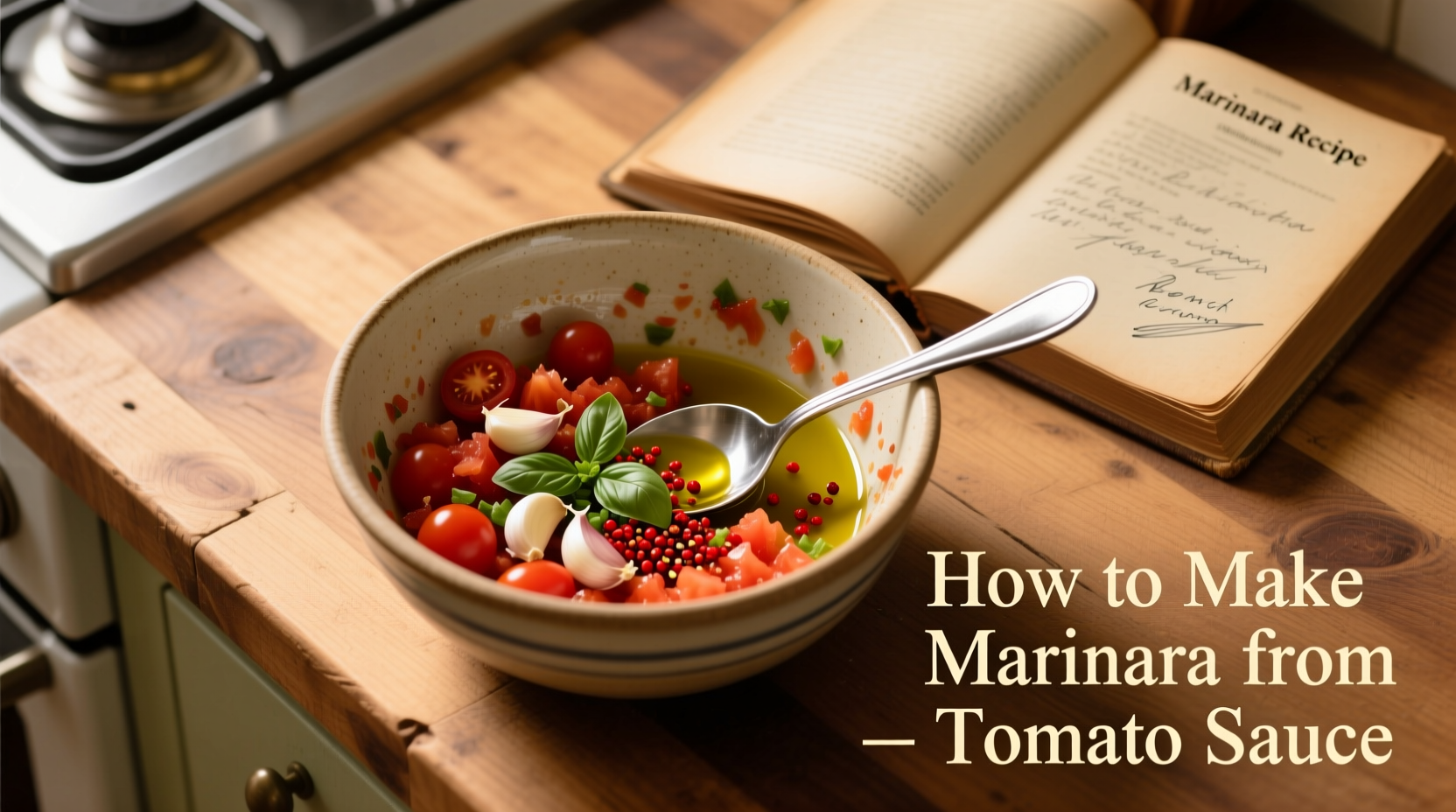Transform basic tomato sauce into authentic marinara in just 20 minutes with this simple method: simmer 1 (24-ounce) can of tomato sauce with 2 minced garlic cloves, 1 teaspoon dried oregano, 1 teaspoon dried basil, 1/2 teaspoon red pepper flakes, and 2 tablespoons olive oil for 15-20 minutes. Add salt to taste and finish with fresh basil. This technique enhances flavor depth while maintaining the bright, fresh character of true marinara.
Why This Simple Transformation Works
Many home cooks mistakenly believe marinara requires starting from whole tomatoes. The truth? Authentic marinara's magic comes from technique and seasoning—not complicated ingredients. As Antonio Batali explains in Italian American, "Marinara's beauty is in its simplicity: garlic, tomatoes, herbs, and time." Transforming store-bought tomato sauce saves 30 minutes compared to scratch preparation while delivering restaurant-quality results.
Tomato Sauce vs. Marinara: Key Differences
| Characteristic | Basic Tomato Sauce | Authentic Marinara |
|---|---|---|
| Preparation Time | Instant (canned) | 20 minutes minimum |
| Herb Profile | Minimal or none | Prominent oregano/basil |
| Garlic Presence | Often absent | Essential foundation |
| Texture | Uniformly smooth | Slightly textured |
| Flavor Complexity | One-dimensional | Layered with umami |
The 4-Step Transformation Process
1. Selecting Your Base Sauce (2 minutes)
Not all tomato sauces work equally well. Choose a simple, unseasoned variety without added sugar or "Italian seasoning." The USDA's National Nutrient Database confirms that basic tomato sauce contains only tomatoes, citric acid, and calcium chloride—making it the perfect blank canvas. Avoid "pasta sauces" which often contain pre-added herbs that will clash with your marinara seasoning.
2. Building Flavor Foundations (5 minutes)
Heat 2 tablespoons extra-virgin olive oil in a medium saucepan over medium-low heat. Add 2-3 minced garlic cloves and 1/2 teaspoon red pepper flakes. Cook gently for 2-3 minutes until garlic becomes fragrant but doesn't brown—this critical step develops flavor without bitterness. As the Culinary Institute of America's Professional Cooking notes, "Garlic's flavor compounds transform dramatically between 130-160°F—too hot creates acrid notes."

3. Simmering for Depth (15 minutes)
Pour in 1 (24-ounce) can of tomato sauce. Stir in 1 teaspoon dried oregano, 1 teaspoon dried basil, and 1 teaspoon sugar (optional, to balance acidity). Bring to a gentle simmer—not a rolling boil—and cook uncovered for 15 minutes, stirring occasionally. This reduces excess liquid while concentrating flavors. The FDA's Food Code recommends maintaining simmering temperatures above 140°F for food safety during extended cooking.
4. Finishing Touches (2 minutes)
Remove from heat. Stir in 2 tablespoons fresh basil and season with salt to taste. For professional results, add a splash of red wine vinegar (1/2 teaspoon) to brighten flavors—this technique appears in Marcella Hazan's Essentials of Classic Italian Cooking. Let rest 5 minutes before serving to allow flavors to meld.
When This Method Shines (and When to Start Fresh)
This transformation works perfectly for weeknight dinners, quick pasta dishes, or when you've run out of marinara. However, food historian John Mariani notes in How Italian Food Conquered the World that "true Neapolitan marinara was born from sailors' need for fast, shelf-stable provisions." For special occasions or when serving tomato-forward dishes like spaghetti aglio e olio, starting with whole San Marzano tomatoes yields superior results.
Pro Tips for Restaurant-Quality Results
- Acidity balance: Add 1/4 teaspoon baking soda if sauce tastes too acidic—this neutralizes pH without adding sweetness
- Texture enhancement: For richer mouthfeel, stir in 1 tablespoon tomato paste during the last 5 minutes of cooking
- Flavor layering: Deglaze the pan with 2 tablespoons red wine after cooking garlic for complex depth
- Storage: Properly stored in airtight containers, this marinara keeps for 5 days refrigerated or 3 months frozen (per USDA food safety guidelines)
Troubleshooting Common Issues
Problem: Sauce tastes metallic
Solution: This indicates overcooked garlic. Next time, add garlic to cooled oil and heat gradually.
Problem: Sauce is too thin
Solution: Simmer uncovered an additional 5-7 minutes, or create a slurry with 1 teaspoon cornstarch and 1 tablespoon water.
Problem: Flavor lacks brightness
Solution: Finish with lemon zest or a splash of good-quality balsamic vinegar—citrus compounds reactivate dormant flavor receptors.
Serving Suggestions That Impress
This versatile sauce works beyond pasta. Try it as:
- Pizza base (spread thinly for authentic Neapolitan style)
- Shakshuka poaching liquid
- Dipping sauce for mozzarella sticks
- Base for quick minestrone soup
For best results, always toss pasta directly in the sauce pan with a splash of pasta water—the starch creates an emulsified, restaurant-quality coating. As Lidia Bastianich emphasizes in Lidia's Mastering the Art of Italian Cuisine, "The marriage of pasta and sauce happens in the pan, not on the plate."











 浙公网安备
33010002000092号
浙公网安备
33010002000092号 浙B2-20120091-4
浙B2-20120091-4